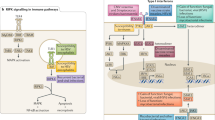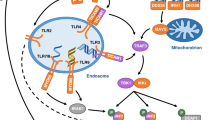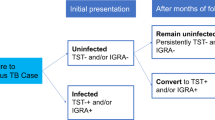Abstract
Host genetic factors are important in determining the outcome of infections caused by intracellular pathogens, including mycobacteria and salmonellae, but until now have been poorly characterized. Recently, some individuals with severe infections due to otherwise weakly pathogenic mycobacteria (non-tuberculous mycobacteria or Mycobacterium bovis bacille Calmette-Guérin) or Salmonella species have been shown to be unable to produce or respond to interferon-γ. This inability results from mutations in any of five genes encoding essential proteins of the type 1 cytokine cascade: interleukin-12p40, interleukin-12Rβ1, interferon-γR1, interferon-γR2 or STAT1. Ten syndromes have thus far been identified. Recent insights in genetically controlled host defense and susceptibility to mycobacterial disease are discussed.
This is a preview of subscription content, access via your institution
Access options
Subscribe to this journal
Receive 12 print issues and online access
$209.00 per year
only $17.42 per issue
Buy this article
- Purchase on Springer Link
- Instant access to full article PDF
Prices may be subject to local taxes which are calculated during checkout


Similar content being viewed by others
Accession codes
References
Hill, A.V.S. The immunogenetics of human infectious disease. Annu. Rev. Immunol. 16, 593–617 (1998).
Abbas, A.K., Murphy, K.M. & Sher, A. Functional diversity of helper T lymphocytes. Nature 383, 787–793 (1996).
Aderem, A. & Ulevitch, R.J. Toll-like receptors in the induction of the innate immune response. Nature 406, 782–787 (2001).
Nakanishi, K., Yoshimoto, T., Tsutsui, H. & Okamura, H. Interleukin-18 regulates both Th1 and Th2 responses. Annu. Rev. Immunol. 19, 423–474 (2001).
Oppmann, B. et al. Novel p19 protein engages IL-12p40 to form a cytokine, IL-23, with biological activities similar as well as distinct from IL-12. Immunity 13, 715–725 (2000).
Parham, C. et al. A receptor for the heterodimeric cytokine IL-23 is composed of IL-12Rβ1 and a novel cytokine receptor subunit, IL-23R. J. Immunol. 168, 5699–5708 (2002).
Pflanz, S. et al. IL-27, a heterodimeric cytokine composed of EB13 and p28 protein, induces proliferation of naive CD4+ T cells. Immunity 16, 779–790 (2002).
Zou, W. et al. Macrophage-derived dendritic cells have strong Th1-polarizing potential mediated by β-chemokines rather than IL-12. J. Immunol. 165, 4388–4396 (2000).
Flynn, J-L. & Chan, J. Immunology of tuberculosis. Annu. Rev. Immunol. 19, 93–129 (2001).
Denis, M. Killing of Mycobacterium tuberculosis within human monocytes: activation by cytokines and calcitriol. Clin. Exp. Immunol. 84, 200–206 (1991).
Bonecini-Almeida, M.G. et al. Induction of in vitro human macrophage anti-Mycobacterium tuberculosis activity: requirement for IFN-γ and primed lymphocytes J. Immunol. 160, 4490–4499 (1998).
Stenger, S., Rosat, J-P., Bloom, B.R., Krensky, A.M. & Modlin, R.L. Granylysin: a lethal weapon of cytolytic T cells. Immunol. Today 20, 390–394 (1999).
Altare, F. et al. Inherited interleukin 12 deficiency in a child with bacille Calmette-Guérin and Salmonella enteritidis disseminated infection. J. Clin. Invest. 102, 2035–2040 (1998).
Picard, C. et al. Inherited interleukin-12 deficiency: IL12B genotype and clinical phenotype of thirteen patients from six kindreds. Am. J. Hum. Genet. 70, 336–348 (2002).
Elloumi-Zghal, H. et al. Clinical and genetic heterogeneity of inherited autosomal recessive susceptibility to disseminated Mycobacterium bovis Bacillus Calmette-Guérin infection. J. Inf. Dis. 185, 1468–1475 (2002).
Frucht, D.M. & Holland, S.M. Defective monocyte costimulation for IFN-γ production in familial disseminated Mycobacterium avium complex infection: abnormal IL-12 regulation. J. Immunol. 157, 411–416 (1996).
Haraguchi, S. et al. Interleukin 12 deficiency associated with recurrent infections. Proc. Natl Acad. Sci. USA 95 13125–13129 (1998).
De Jong, R. et al. Severe mycobacterial and Salmonella infections in interleukin-12 receptor-deficient patients. Science 280, 1435–1438 (1998).
Altare, F. et al. Impairment of mycobacterial immunity in human interleukin-12 receptor deficiency. Science 280, 1432–1435 (1998).
Lichtenauer-Kaligis, E.G.R. et al. Severe outcome of Mycobacterium bovis BCG infections in an unexpectedly large series of novel IL-12 receptor β1 deficient patients, and evidence for the existence of partial IL-12R deficiency. Submitted for publication.
Verhagen, C.E. et al. Residual type 1 immunity in patients genetically deficient for interleukin 12 receptor β1 (IL-12Rβ1): evidence for an IL-12Rβ1-independent pathway of IL-12 responsiveness in human T cells. J. Exp. Med. 192, 517–528 (2000).
Sakai, T., Matsuoka, M., Aoki, M., Nosaka, K. & Mitsuya, H. Missense mutation of the interleukin-12 receptor β1 chain-encoding genes is associated with impaired immunity against Mycobacterium avium complex infection. Blood 97, 2688–2694 (2001).
Altare, F. et al. Interleukin-12 receptor β1 deficiency in a patient with abdominal tuberculosis. Clin. Infect. Dis. 184, 231–236 (2001).
Aksu, G. et al. Mycobacterium fortuitum-chelonae complex infection in a child with complete interleukin-12 receptor β 1 deficiency. Pediatr. Infect. Dis. J. 20, 551–553 (2001).
Wu, C.-Y. et al. IL-12 receptor β2 (IL-12Rβ2)-deficient mice are defective in IL-12-mediated signaling despite the presence of high affinity IL-12 binding sites. J. Immunol. 165, 6221–6228 (2000).
Decken, K. et al. Interleukin-12 is essential for a protective Th1 response in mice infected with Cryptococcus neoformans. Infect. Immun. 66, 4994–5000 (1998).
Brombacher, F. et al. IL-12 is dispensable for innate and adaptive immunity against low doses of Listeria monocytogenes. Int. Immunol. 11, 325–332 (1999).
Cooper, A.M. et al. Mice lacking bioactive IL-12 can generate protective, antigen-specific cellular responses to mycobacterial infection only if the IL-12 p40 subunit is present. J. Immunol. 168, 5699–5708 (2002).
Gollob, J.A. et al. Impairment of STAT activation by IL-12 in a patients with atypical mycobacterial and staphylococcal infections. J. Immunol. 165, 4120–4126 (2000).
Ortmann, R., Smeltz, R., Yap, G., Sher, A. & Shevach, E.M. A heritable defect in IL-12 signaling in B10.Q/J mice. I. In vitro analysis. J. Immunol. 166, 5712–5719 (2001).
Rogge, L. et al. Transcript imaging of the development of human T helper cells using oligonucleotide arrays. Nature Genet. 25, 96–101 (2000).
Colantonio, L. et al. Upregulation of integrin α6/β1 and chemokine receptor CCR1 by interleukin-12 promotes the migration of human type 1 helper T cells. Blood 94, 2981–2989 (1999).
Keane, J. et al. Tuberculosis associated with infliximab, a tumor necrosis factor α-neutralizing agent. N. Engl. J. Med. 345, 1098–1104 (2001).
Jouanguy, E. et al. A novel form of IFN-γ receptor 1 deficiency, cell surface receptors fail to bind IFN-γ. J. Clin. Invest. 105, 1429–1436 (2000).
Allende, L.M. et al. A point mutation in a domain of γ interferon receptor 1 provokes severe immunodeficiency. Clin. Diagn. Lab. Immunol. 8, 133–137 (2001).
Jouanguy, E. et al. Partial interferon-γ receptor 1 deficiency in a child with tuberculoid bacillus Calmette-Guerin infection and a sibling with clinical tuberculosis. J. Clin. Invest. 100, 2658–2664 (1997).
Jouanguy, E. et al. A human IFNGRl small deletion hotspot associated with dominant susceptibility to mycobacterial infection. Nature Genet. 21, 370–378 (1999).
Arend, S.M. et al. Multifocal osteomyelitis caused by nontuberculous mycobacteria in patients with genetic defect of the interferon-γ receptor. Neth. J. Med. 59, 140–151 (2001).
Sasaki, Y. et al. Genetic basis of patients with Bacille Calmette-Guérin osteomyelitis in Japan: identification of dominant partial interferon γ receptor 1 deficiency as a predominant type. J. Inf. Dis. 185, 706–709 (2002).
Villella, A. et al. Recurrent Mycobacterium avium osteomyelitis associated with a novel dominant interferon γ receptor mutation. Pediatrics 107, e47 (2001).
Döffinger, R. et al. Partial interferon-γ receptor signalling chain deficiency in a patient with bacille Calmette-Guerin and Mycobacterium abscessus infection. J. Infect. Dis. 181, 379–384 (2000).
Dupuis, S. et al. Human interferon-γ-mediated immunity is a genetically controlled continuous trait that determines the outcome of mycobacterial invasion. Immunol. Rev. 178, 129–137 (2000).
Dupuis, S. et al. Impairment of mycobacterial but not viral immunity by a germline human STAT1 mutation. Science 293, 300–303 (2001).
Dorman, S.E. et al. Viral infections in interferon-γ receptor deficiency. J. Pediatr. 135, 640–643 (1999).
Verreck, F.A.W. et al. Human host defence and cytokines in mycobacterial infectious diseases: interleukin-18 cannot compensate for genetic defects in the interleukin–12 system. Clin. Infect. Dis. 35, 210–212 (2002).
Ottenhoff, T.H.M., Kumararatne, D. & Casanova, J.L. Novel human immunodeficiencies reveal the essential role of type-1 cytokines in immunity to intracellular bacteria. Immunol. Today 19, 491–494 (1998).
Dorman, S.E. & Holland, S.M. Interferon-γ and interleukin-12 pathway defects and human disease. Cytokine Growth Factor Rev. 11, 321–333 (2000).
Roesler, J. et al. Listeria monocytogenes and recurrent mycobacterial infections in a child with complete interferon-γ-receptor deficiency: mutational analysis and evaluation of therapeutic options. Exp. Hematol. 27, 1368–1374 (1999).
Janssen, R. et al. Divergent role for TNF-α in IFN-γ induced killing of Toxoplasma gondii and Salmonella typhimurium contributes to selective susceptibility of patients with partial IFN-γR1 deficiency. J. Immunol. (in the press).
Casanova, J.-L. & Abel, L. Genetic dissection of immunity to mycobacteria: the human model. Annu. Rev. Immunol. 20, 581–620 (2002).
Ting, L.-M., Kim, A.C., Cattamanchi, A. & Ernst, J.D. Mycobacterium tuberculosis inhibits IFN-γ transcriptional responses without inhibiting activation of STAT1. J. Immunol. 163, 3898–3906 (1999).
Nau, G.J. et al. Human macrophage activation programs induced by bacterial pathogens. Proc. Natl Acad. Sci. USA 99, 1503–1508 (2002).
Cooke, G.S. & Hill, A.V.S. Genetics of susceptibility to human infectious disease. Nature Rev. Genet. 2, 967–977 (2001).
Döffinger, R. et al. X-linked anhidrotic ectodermal dysplasia with immunodeficiency is caused by impaired NF-κB signaling. Nature Genet. 27, 277–285 (2001).
Selvaraj, P., Narayanan, P.R. & Reetha, A.M. Association of functional mutant homozygotes of the mannose binding protein gene with susceptibility to pulmonary tuberculosis in India. Tuberc. Lung Dis. 79, 221–227 (1999).
Wilkinson, R.J. et al. Influence of polymorphism in the genes for the interleukin (IL)-1 receptor antagonist and IL-1β on tuberculosis. J. Exp. Med. 189, 1863–1874 (1999).
Greenwood, C.M.T. et al. Linkage of tuberculosis to chromosome 2q35 loci, including NRAMP1, in a large aboriginal Canadian family. Am. J. Hum. Genet. 67, 405–416 (2000).
Siddiqui, M.R. et al. A major susceptibility locus for leprosy in India maps to chromosome 10p13. Nature Genet. 27, 439–441 (2001).
Burghes, A.H.M., Vaessin, H.E.F. & de La Chapelle, A. The land between Mendelian and multifactorial inheritance. Science 293, 2213–2214 (2001).
Newport, M.J. et al. A mutation in the interferon-γ-receptor gene and susceptibility to mycobacterial infection. N. Engl. J. Med. 335, 1941–1949 (1996).
Jouanguy, E. et al. Interferon-γ-receptor deficiency in an infant with fatal bacille Calmette-Guerin infection. N. Engl. J. Med. 335, 1956–1961 (1996).
Holland, S.M. et al. Abnormal regulation of interferon-γ, interleukin-12, and tumor necrosis factor-α in human interferon-γ receptor I deficiency. J. Infect. Dis. 178, 1095–1104 (1998).
Pierre-Audigier, C. et al. Fatal disseminated Mycobacterium smegmatis infection in a child with inherited interferon γ receptor deficiency. Clin. Infect. Dis. 24, 982–984 (1997).
Altare, F. et al. A causative relationship between mutant IFNγ R1 alleles and impaired cellular response to IFNγ in a compound heterozygous child. Am. J. Hum. Genet. 62, 723–726 (1998).
Rosenzweig, S. et al. 561del4 defines a novel small deletion hotspot in the interferon-γ receptor 1 chain. Clin. Immunol. 102, 25–27 (2002).
Cunningham, J.A. et al. Disseminated bacille Calmette-Guerin infection in an infant with a novel deletion in the interferon-γ receptor genes. Int. J. Tuberc. Lung Dis. 4, 791–794 (2000).
Noordzij, J.G. et al. Complete defects in interferon γ receptor dependent signaling are associated with different clinical phenotypes. Pediatr. Res. (in the press).
Edgar, J.D. et al. Interferon-γ receptor deficiency mimicking Langerhans' cell histiocytosis. J. Pediatr. 139, 600–603 (2001).
Dorman, S.E. & Holland, S.M. Mutation in the signal-transducing chain of the interferon-γ receptor and susceptibility to mycobacterial infection. J. Clin. Invest. 101, 2364–2369 (1998).
Holland, S.M. Immune deficiency presenting as mycobacterial infection. Clin. Rev. Allergy Immunol. 20, 121–137 (2001).
Acknowledgements
This work was supported by the Netherlands Leprosy Foundation, the Commission of the European Communities, Netherlands Organization for Scientific Research (NWO/ZON-MW) and the Royal Netherlands Academy of Arts and Sciences. We thank R.R.P. de Vries and C.J.M. Melief for critically reading the manuscript.
Author information
Authors and Affiliations
Corresponding author
Rights and permissions
About this article
Cite this article
Ottenhoff, T., Verreck, F., Lichtenauer-Kaligis, E. et al. Genetics, cytokines and human infectious disease: lessons from weakly pathogenic mycobacteria and salmonellae. Nat Genet 32, 97–105 (2002). https://doi.org/10.1038/ng0902-97
Received:
Accepted:
Issue Date:
DOI: https://doi.org/10.1038/ng0902-97
This article is cited by
-
Susceptibility to mycobacterial disease due to mutations in IL-12Rβ1 in three Iranian patients
Immunogenetics (2018)
-
Disseminated nontuberculous mycobacterial infection with multifocal retinitis and vasculitis in an immunocompromised patient with anti-IFN-ɣ autoantibodies
Journal of Ophthalmic Inflammation and Infection (2016)
-
The rLrp of Mycobacterium tuberculosis inhibits proinflammatory cytokine production and downregulates APC function in mouse macrophages via a TLR2-mediated PI3K/Akt pathway activation-dependent mechanism
Cellular & Molecular Immunology (2016)
-
Anakinra treatment in drug-resistant Behcet’s disease: a case series
Clinical Rheumatology (2015)
-
Recombinant TB9.8 of Mycobacterium bovis Triggers the Production of IL-12 p40 and IL-6 in RAW264.7 Macrophages via Activation of the p38, ERK, and NF-κB Signaling Pathways
Inflammation (2015)



